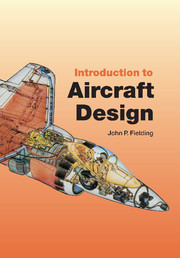Book contents
- Frontmatter
- Contents
- Preface
- Acknowledgements
- 1 Introduction
- 2 Why should we design a new aircraft?
- 3 Why is it that shape? – Civil aircraft
- 4 Why is it that shape? – Other types
- 5 What's under the skin? – Structure and propulsion
- 6 What's under the skin? – Airframe systems
- 7 What's under the skin? – Avionics, flight control and weapon systems
- 8 Why do aircraft cost so much?
- 9 What help can I get? – Bibliography and computer-aided design
- 10 The shape of things to come – Should the project continue?
- 11 What can go wrong? – Some lessons from past aircraft projects, and a glimpse into the future
- Appendix A Useful aircraft design data
- Appendix B A–90 parametric study. Example – the A-90 500-seat airliner
- Appendix C The prediction of aircraft reliability and maintainability targets
- References
- Index
4 - Why is it that shape? – Other types
- Frontmatter
- Contents
- Preface
- Acknowledgements
- 1 Introduction
- 2 Why should we design a new aircraft?
- 3 Why is it that shape? – Civil aircraft
- 4 Why is it that shape? – Other types
- 5 What's under the skin? – Structure and propulsion
- 6 What's under the skin? – Airframe systems
- 7 What's under the skin? – Avionics, flight control and weapon systems
- 8 Why do aircraft cost so much?
- 9 What help can I get? – Bibliography and computer-aided design
- 10 The shape of things to come – Should the project continue?
- 11 What can go wrong? – Some lessons from past aircraft projects, and a glimpse into the future
- Appendix A Useful aircraft design data
- Appendix B A–90 parametric study. Example – the A-90 500-seat airliner
- Appendix C The prediction of aircraft reliability and maintainability targets
- References
- Index
Summary
Military aircraft types
Fighters
These aircraft have had several designations over the years, including pursuit and interceptor aircraft. There are many types, and definitions become blurred between fighters and bombers and ground-attack aircraft. True fighters may be divided into two major classes. The first class is that of relatively simple short-range interceptor aircraft (class 1), whilst the second used to be called ‘all-weather’ fighters which tend to have longer range and more avionic equipment (class 2). Figure 4.1 shows a plot of combat wing loading against thrust/weight ratio, which is a good indication of the manoeuvrability of combat aircraft (see Chapter 3 for the definition of thrust/weight and wing loading). Recent requirements for high agility have moved aircraft towards the top left-hand corner where high thrust/weight and low wing loading improve climb, sustained turn and attained turn performance. Most aircraft in this region are class 1 short-range fighters and class 2 are closer to the bottom-right quadrant, where the higher wing loading leads to better long-range cruise.
The class 1 short range, high performance interceptor carries the minimum of equipment and maximum speed is always important. However for such an aircraft the rate of climb and manoeuvrability may be even more important. This arises from the fact that due to the fighter's necessarily short range it cannot take off until a target is definitely located, but must then rapidly climb to interception.
- Type
- Chapter
- Information
- Introduction to Aircraft Design , pp. 37 - 54Publisher: Cambridge University PressPrint publication year: 1999



